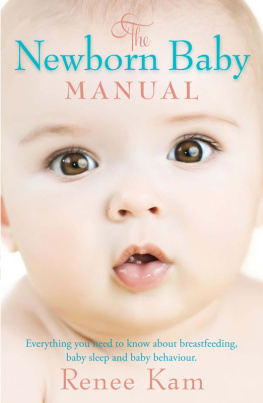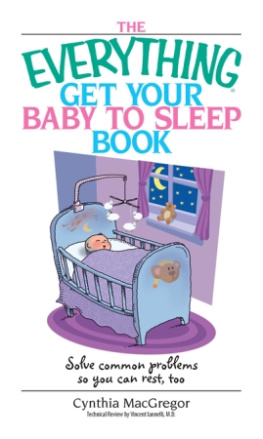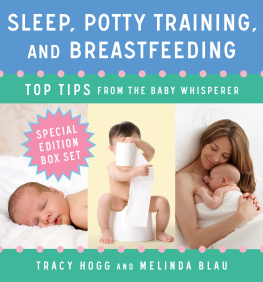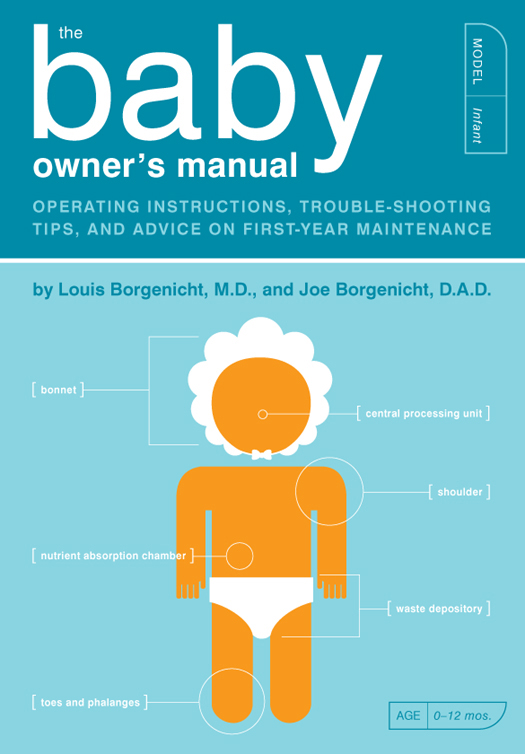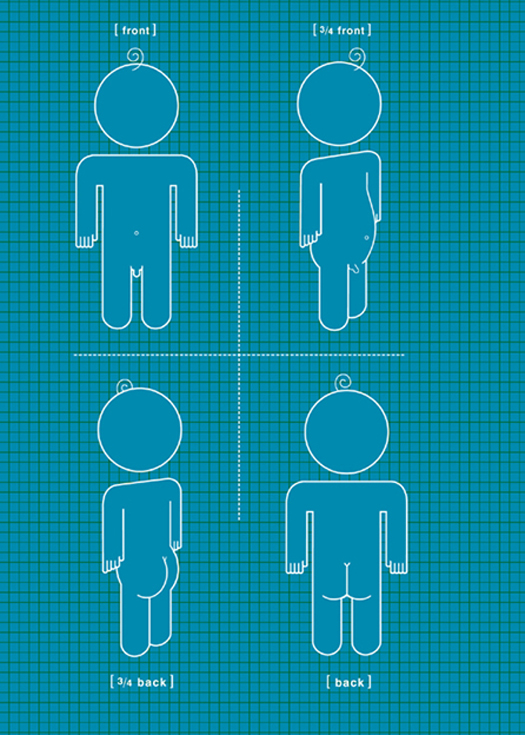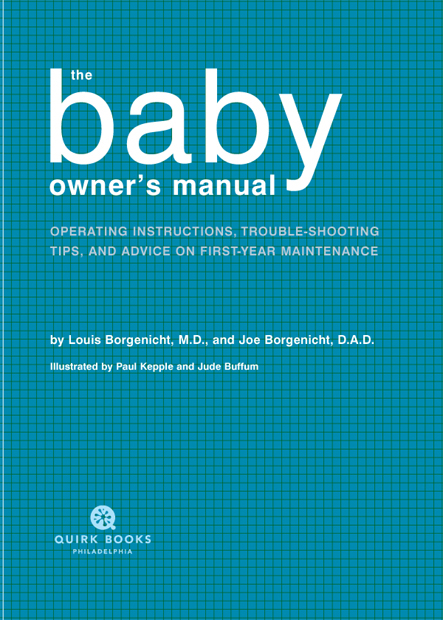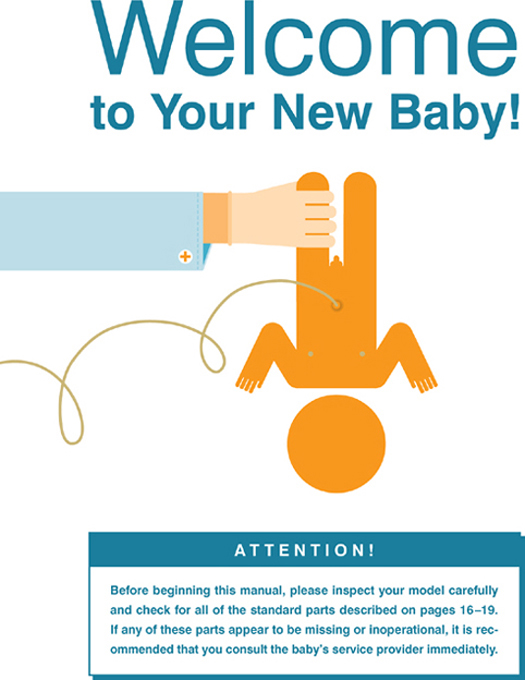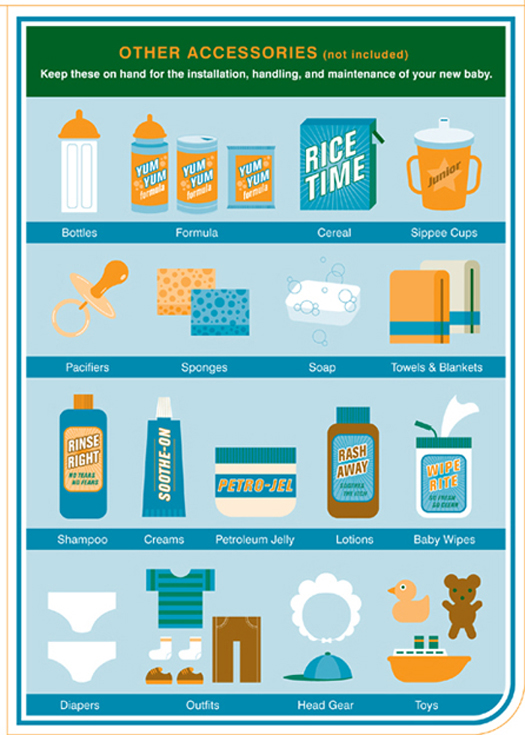Copyright 2003, 2012 by Quirk Productions, Inc.
Second edition 2012. Illustrations copyright 2003, 2012 by Headcase Design
All rights reserved. No part of this book may be reproduced in any form without written permission from the publisher.
Library of Congress Cataloging in Publication Number: 2012900532
eISBN: 978-1-59474-609-3
Designed by Paul Kepple and Jude Buffum @ Headcase Design
Production management by John J. McGurk
Quirk Books
215 Church Street
Philadelphia, PA 19106
quirkbooks.com
v3.1_r1
Contents
CHAPTER 1:
PREPARATION AND HOME INSTALLATION
CHAPTER 2:
GENERAL CARE
CHAPTER 3:
FEEDING: UNDERSTANDING THE BABYS POWER SUPPLY
CHAPTER 4:
PROGRAMMING SLEEP MODE
CHAPTER 5:
GENERAL MAINTENANCE
CHAPTER 6:
GROWTH AND DEVELOPMENT
CHAPTER 7:
SAFETY AND EMERGENCY MAINTENANCE
Congratulations on the arrival of your new baby.
This baby is surprisingly similar to other appliances you may already own. Like a personal computer, for instance, the baby will require a source of power to execute her many complicated tasks and functions. Like an inkjet printer, the babys head will require frequent cleanings for optimum performance. And like an automobile, the baby may expel unpleasant odors into the atmosphere.
But there is one major difference: personal computers, inkjet printers, and automobiles all come with instruction manuals. Newborn babies do nothence the book you are holding in your hands. The Baby Owners Manual is a comprehensive users guide to deriving maximum performance and optimal results from your newborn.
It is not necessary to read this entire manual cover to cover. For ease of use, this guide has been divided into seven separate sections. If you have a question or encounter a problem, just turn to any of the following chapters:
PREPARATION AND HOME INSTALLATION () describes the best ways to anticipate the arrival of the baby. It features useful information on the configuration of the babys nursery and the selection of transportation accessories (including popular devices known as strollers and carriers).
GENERAL CARE () features effective techniques for handling, holding, and comforting the baby. It also illustrates complex procedures such as swaddling and baby massage, and presents toy accessories that may enhance the babys intelligence.
FEEDING () offers an in-depth guide to understanding the babys power supply. This chapter includes detailed instructions on breastfeeding, bottle-feeding, burping the baby, and the introduction of solid food.
PROGRAMMING SLEEP MODE (instructions on sleep malfunction, dealing with overstimulation, and configuring the babys sleeping area.
GENERAL MAINTENANCE () is important for the safety, sanitation, and well-being of all newborn models. This chapter features detailed instructions on re-installing diapers, cleaning the baby, and shortening the babys hair.
GROWTH AND DEVELOPMENT () teaches the user how to test baby reflexes and identify important milestones. This chapter also explains advanced motor and sensory applications, such as crawling, pulling up, and baby talk.
SAFETY AND EMERGENCY MAINTENANCE () explores the best ways to childproof the babys environment. It also features extremely important advice on the Heimlich maneuver and cardiopulmonary resuscitation, and monitoring the babys health. Users can also refer to an A-to-Z guide of minor medical conditions like cradle cap, hiccups, and pink eye.
When used properly, the baby will provide years of love, devotion, and joy. But understanding how to use the baby takes practice, so it is important to be patient. Over the next few months, you may experience feelings of frustration, incompetence, hopelessness, and despair. These feelings are all normaland, in time, this too shall pass. One day in the near future, the ideas of changing diapers and warming a breast milk bottle will seem as easy to you as booting up a PC or setting the alarm on your smartphone. And then you will know that you have truly mastered baby ownership.
Good luckand enjoy your new baby!
The Baby:Diagram and Parts List
Virtually all current models come pre-installed with the following features and capabilities. If the baby is missing one or more of the functions described herein, contact the babys service provider immediately.
The Head
Head: May initially appear unusually large or even cone-shaped, depending on model and delivery option. A cone-shaped head will become more rounded after four to eight weeks.
Circumference: The average head circumference of all models is 13.8 inches (35 cm). Any measurement between 12.9 and 14.7 inches (3237 cm) is considered normal.
Hair: Not available upon delivery with every model. Tint may vary.
Fontanels (Anterior and Posterior): Also known as soft spots. Fontanels are two gaps in the babys skull where the bones have not grown together. Never apply pressure to the fontanels. They should seal completely by the end of the first year (or soon after).
Eyes: Most Caucasian models are delivered with blue or gray eyes, while African and Asian models are usually delivered with brown eyes. Be aware that the pigmentation of the iris may change several times during the first few months. The baby will automatically settle on an eye color by the age of nine to twelve months.
Neck: Upon arrival, this feature may appear useless. This is not a defect. The neck will become more useful in two to four months.
The Body
Skin: The babys skin may be exceptionally sensitive to the chemicals found in new (unwashed) garments. The skin may react poorly to the chemicals in ordinary laundry detergent. Consider switching to a fragrance-free, chemical-free detergent for all of the laundry in the household.
Umbilical Stump: This appendage will become scabbed and, after several weeks, will fall off. It must be kept clean and dry to avoid infection and to form a healthy navel (see ).


